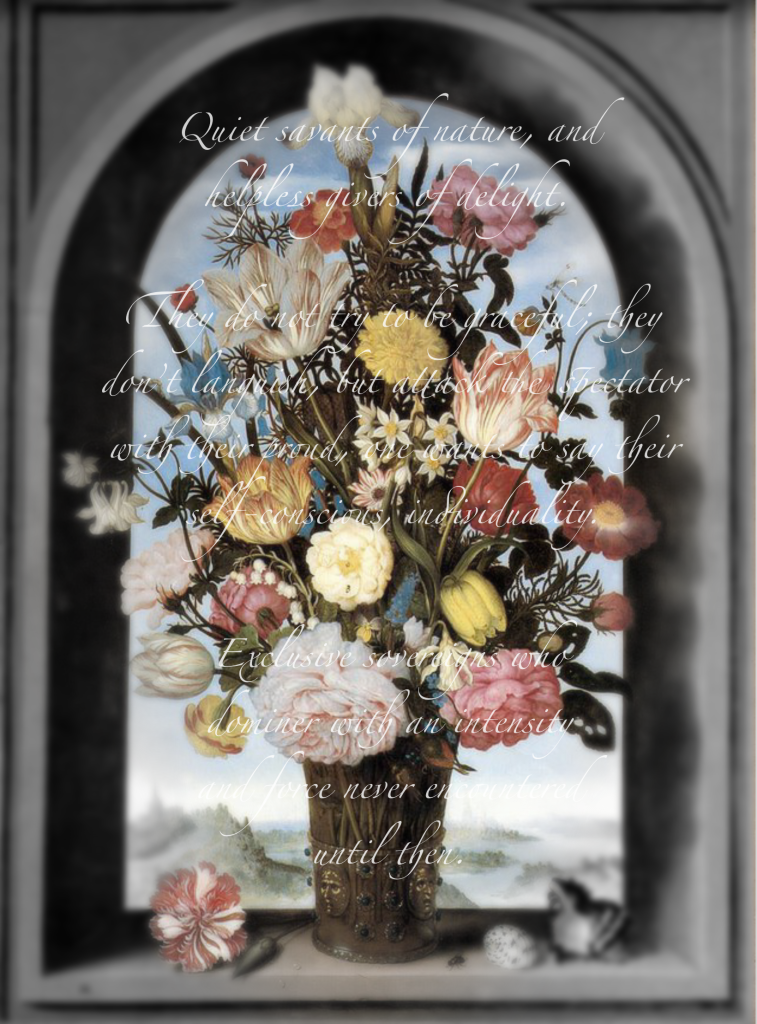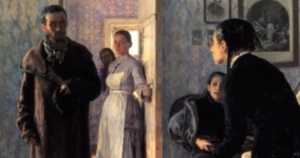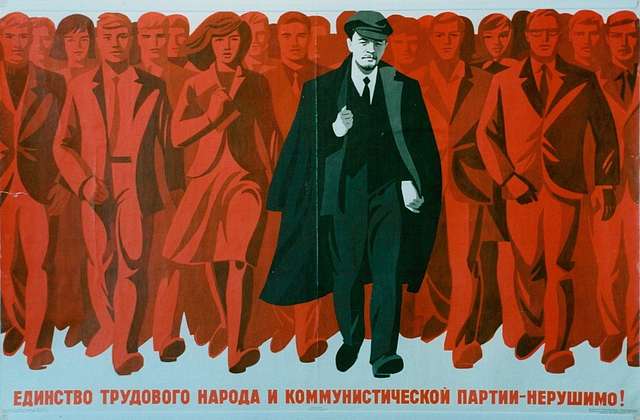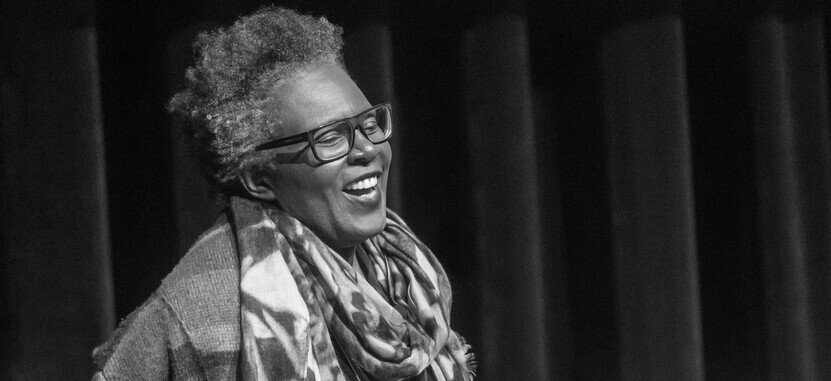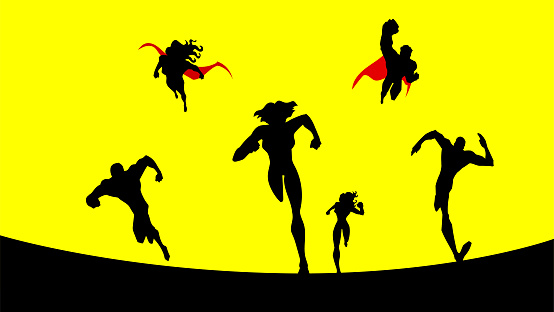
A silhouette style vector illustration
by Alexei L. Villareal
CONTENT WARNING: The following essay contains offensive language and discussions of sexual assault which some readers may find disturbing.
Superhero fiction has had a long history of presenting ensembles of characters that reinforce a bastion of heteronormativity. Amidst conventional representations of gender and sexuality, Alan Moore and Dave Gibbons’ Watchmen introduces a team of masked crimefighters who complicate the definition of heroism and redefine heroic sexuality. Since its publication in 1986 and 1987, the comic has been the recurring subject of extensive analysis for its intricate and colourful narrative frames, ever-shifting perspectives, and depictions of seemingly heterosexual characters inhabiting a world of dangerous queerness. With a cast of perplexingly complex heroes, Watchmen deconstructs the genre of superhero fiction by refashioning the heroic vogue of costumes, masks, and tights in order to expose the contradictions within its medium’s gendered and sexually bound conventions.
Throughout Watchmen, Moore and Gibbons refine the comic aesthetic by imitating industry practices while simultaneously reinventing them. They challenge the medium’s heteronormative attitudes and disrupt it with the existence of queer characters in spaces of heterosexual locales. Under Moore and Gibbons’ lens, any expression of gender and sexuality that defies the norm is queer and “uncontainable by a single, definite sexual identity” (Stein 31). From panel to panel and between gutters, heroes with deviant gender and sexual orientations occupy the pages of Watchmen. In his discussion of superheroes and popular body politics, Daniel Stein proposes an intersection of queer expression and heroic fashion that attributes the physicality of the body to the selected costume of the hero:
The superhero inhabits a body that deviates from real-life bodies and may therefore queer mainstream views of gender and sexuality rooted in references to the physical body. As a social outcast who must hide or sublimate a secret (and occasionally sexual) identity… the superhero has the potential to queer normative notions of male and female corporeality despite its overt promotion of an idealized and hypersexualized heteronormative body (20).
As Rorschach, Walter Kovacs restricts himself to his incognito to condemn lust (Moore and Gibbons I.9.3, I.22.5, II.67.2-3, V.155.5, IX.320.4-5). Under the guise of Silk Spectre, Sally Jupiter exemplifies sex symbolism, and is constantly hypersexualized by the perverted public (II.46.2-4, IX.309, IX.312). Dan Dreiberg cures himself of his erectile dysfunction with the sexual confidence he gains as Nite Owl (VII.226.3-8, VII.227.1-3, VII.231.7-8, VII.232.1-2, VII.239-240, XII.407.4; Paul 12:18-13:03). Alienated from his body, Jonathan Osterman’s romantic and sexual desires weaken as he appropriates the identity of Doctor Manhattan (Moore and Gibbons III.80). By donning a mask and costume, characters, both straight and queer, are able to explore avenues of their sexuality previously inaccessible to them.
The public and their perception of superheroes is crucial to understanding how the dichotomy of heteronormativity and queerness operates within the Watchmen universe. In a flashback, a mob of protesters take to the streets when confronted with the possibility of the implementation of a superhero task force. Unnerved by their anonymity, their placards read, “BADGES NOT MASKS” (Moore and Gibbons IV.132.4, VI.193.6). One rioter cries, “We don’want [sic] vigilantes! We want reg’lar [sic] cops!” (II.59.2). The heroes are also met with derogatory and homophobic slurs: the Comedian and Nite Owl are called “faggots” (II.59.2), Doctor Manhattan is referred to as a “big blue fruit” (IV.132.4), and unmasked in police custody, Rorschach is derided as a “goddamned queer” (V.172.5). As their taunts make clear, the public’s defamation of their heroes is deliberately homophobic. Othered for their queerness, the heroes are collectively made the subject of the public’s discriminatory slander. All throughout the comic, walls covered in graffiti read, “WHO WATCHES THE WATCHMEN?” (I.17.7, I.32.1, II.60.3-6, VI.193.6, VIII.247.9, VIII.248.7, VIII.272.7, VIII.274.5-6, XII.413.5). The public fears what they do not understand, and the possible existence of queer heroes in their midst heralds their civil unrest. With intense scrutiny, the public eye watches, keenly aware of the queerness that drives the vigour of their heroes.
Of the first generation of masked heroes known as the Minutemen, Ursula Zandt, the Silhouette is one of the few characters in the comic to be explicitly acknowledged as queer. Within the fiction, the most notable commentator on the sexual deviancy and queerness of the costumed heroes is Hollis Mason, the first Nite Owl. In his autobiography Under the Hood, he addresses the alleged rumours surrounding his masked peers’ sexual tendencies:
Yes, I daresay some of us did have our sexual hang-ups. Everybody knows what eventually became of the Silhouette and although it would be tasteless to rehash the events surrounding her death in this current volume, it provides proof for those who need it that for some people, dressing up in a costume did have its more libidinous elements… Yes, we were crazy, we were kinky… all those things that people say… we did too much good in our respective communities to be written off as mere aberration, whether social or sexual or psychological (Moore and Gibbons II.72).
In a newspaper article, the Silhouette was later revealed to have been “living with another woman in a lesbian relationship” (II.74). In fear of bad press, she was dismissed from the team and eventually murdered alongside her partner (II.74), implying that the gender and sexual identities of public figures must conform to the public’s heteronormative expectations. Unlike “a couple of the guys” (IX.312) on the Minutemen who were also gay, the Silhouette was the only one who had been publicly outed. As illustrated by her chosen alter ego and the shades of her jet-black ensemble (II.47.1-5, II.73), her queer existence is forcibly relegated to the shadowy backdrops of her heteronormative surroundings. Her death casts a shadow over the consequences the masked heroes must face should their queerness come to light.
The fictional public is not alone in their discomfort about queer masked avengers. In his essay, “Hooded Justice and Captain Metropolis: The Ambiguously Gay Duo,” Robert Arp describes his discomfort with the projection of homosexuality onto Hooded Justice and Captain Metropolis:
Superheroes are stereotypically hypermasculine “real men.” That’s why it’s hard to accept that Hooded Justice and Captain Metropolis may be gay… I have to admit that when I first read about Hooded Justice and Captain Metropolis, I said, “Oh, no,” and closed the book. I have a visceral negative reaction to the thought of another man looking at me with desire or “wanting me,” and I’m basically uncomfortable with the gay life style (Arp 185-186).
With his prejudicial remarks, Arp reinforces a common bias against gay masculinity. He argues that the homosexuality of Hooded Justice and Captain Metropolis and their “ambiguously gay” relationship disrupts the hegemonic masculinity associated with their heroism. However, for as much as Arp suggests that their queerness is open to debate, both Hooded Justice and Captain Metropolis are frequently recognized by their teammates as gay. Commenting on the gossip between Hooded Justice and Silk Spectre as “something of an item” (Moore and Gibbons IX.309), Hollis recalls that “even though Sally would always be hanging onto his arm, he never seemed very interested in her” (II.73, italics theirs). A letter to Sally Jupiter from Laurence Schexnayder, the Minutemen’s publicist, expresses concern for the team’s reputation if word of their love affair got out:
Nelly called last night, upset over yet another tiff with H.J. Those two are getting worse. The more they row and act like an old married couple in public, the harder they are to cover for… it would be the Silhouette fiasco all over again (IX.311).
If Hooded Justice and Captain Metropolis’ homosexuality disturbs the reading experience of an uncompromising essayist, then their characterization as a queer couple ultimately establishes the context for the reception of other queer intimacies in Watchmen.
At a glance, the omnipotent and omniscient Doctor Manhattan appears to be the paradigm of heroism and masculinity. However, as a “puppet who can see the strings” (Moore and Gibbons IX.285.4) he becomes increasingly distant from humanity, acknowledging his fading attachment to the world: “I am tired of this world; these people. I am tired of being caught in the tangle of their lives” (IV.135.6). This sense of disinterest in human activity is conjoined with his lack of romantic and sexual inclinations. Prior to his accident, flashbacks reveal Doctor Manhattan as Jonathan Osterman in a healthy, straight relationship with a woman named Janie Slater. The heteronormativity of their romance is captured by traditional courtship: they enjoy casual banter over a beer (IV.115.5-6), go on dates at the amusement park (IV.116.2-5), flirt (IV.117.1), and have sex (IV.116.7-8). Following his disintegration, Jonathan’s appearance and outlook on life are irreparably reoriented. His relationship subsequently falls to shambles, prompting him to leave Janie for Laurie Juspeczyk. The permanence of Doctor Manhattan’s mask and laxity for the social significance of clothing then establishes the foundation for his body alienation and the construction of his own queer identity.
The metamorphosed union of Doctor Manhattan’s neo-divinity and proto-mortality disorients his sexuality in an analogous manner from which he is alienated from his body. In an attempt to satisfy both Laurie and a sense of productivity, he creates duplicates of himself while he works on a project in another room (Moore and Gibbons III.80-81). Laurie considers the act to be sexually transgressive, provoking her to leave him. As she walks out the door, Doctor Manhattan confesses that “[he does not] know what stimulates [her] anymore” (III.80.7) and that “[he] could not love her as she had loved [him]” (III.80.1). After their separation, Janie Slater harks back on her relationship with Doctor Manhattan in an interview, maligning what would today be seen as his aro-ace tendencies: “I said, ‘Jon, you know how every damn thing in this world fits together except people!’ He couldn’t relate to me. Not emotionally. Certainly not sexually” (III.81-82). When Doctor Manhattan idly holds Laurie’s bra in his hand, failing to understand its significance, the bra becomes a symbol for his sexual frustrations (III.85.2). While he would like to subscribe to romance and sex, aromanticism and asexuality are innate to his new form. As Dan and Laurie make plans for dinner, Doctor Manhattan smiles, looking onward (I.31.8-9). Toward the comic’s end, he presents the same smile when he happens upon their naked bodies (XII.407.4-5). Though the upturned corners of his mouth convey the acceptance of his aro-ace, Doctor Manhattan is finally able to embrace the queerness of his heroic identity, content that Laurie has found someone who satisfies her romantic and sexual needs.
Like Doctor Manhattan, the masked vigilante Rorschach expresses a queerness encoded within his perturbation from romance and sex. He is characterized by his iconic mask, a masqueraded identity of black ink on white fabric (Moore and Gibbons I.14.1). A troubled child, he was born Walter Kovacs, his father estranged and his mother a sex worker. Rorschach’s childhood largely contributes to the manifestation of his asexuality. As a young boy, he comes across his mother with a client one night (VI.181-182). From then onward, he begins to abhor sexual desire, feeling repugnance towards “dirty feelings, thoughts and stuff” (VI.210). As a child, he was described to be “quiet and shy, especially with women” (VI.208). On many occasions, Rorschach likens sexuality to sin, denoted by his low opinion of his mother (V.155.4, VI.186.2-3, VI.209, VI.189.8). While Walter Kovacs may have wrestled with sexual frustration, he later lapses into a preferable interpretation of his sexuality, or lack thereof, by assuming the role of Rorschach. With his mask, he becomes “free from fear or weakness or lust” (V.162.6). It is amorphous, blind, black and white, thereby typifying the binaries of his worldview (Paul 10:40-11:00). His upbringing has polarized him to a temper of anti-sexuality just as it has urged him to fight crime.
Together, his desire to enact justice and his lack of desire to enact his sexuality are consummated by his alter ego. When Rorschach identifies his mask to be “[his] face” (Moore and Gibbons V.162.7), his desire to be free from the constraints of sexuality is realized. By entrenching his outlook on his sexual orientation with a reference to his eyes, Rorschach implies asexuality and aromanticism within his gaze: “It was Kovacs who closed his eyes. It was Rorschach who opened them again” (VI.199.6-7).
Rorschach’s concept of romance and sex appear to soften whenever he is stripped of his mask. Although he maintains the general persona of his alter ego, he conversely deviates from his aromantic and asexual tendencies. When the two are alone together in the Owlship, Rorschach grips Dan’s hands in a handshake that lasts longer than Dan is comfortable with (Moore and Gibbons X.324.7-9, X.325.1-2). In her discussion of body representation in the comic book medium, Van Ness touches on facial expressions and body language cues as “two interrelated visual languages that we all use in our daily lives to convey (or suppress) information about our emotions to others” (Van Ness 42). Considering this handshake, if Rorschach does in fact experience romantic attraction, his body language in this scene suggests that it would likely be towards men.
Following in the footsteps of Hollis Mason, Dan Dreiberg assumes the heroic alter ego of Nite Owl in order to arouse his sexuality. Forced into retirement due to the Keene Act (Moore and Gibbons IV.133), Dan’s demotion from extraordinary hero to ordinary civilian slumps him into dispirited dejection, his lack of confidence pervading his casual dalliances with Laurie. In contrast, the salience of hegemonic masculinity in Watchmen is assimilated by Adrian Veidt, also known as Ozymandias. One night, as Laurie and Dan engage in clumsy, uncoordinated foreplay, Adrian’s muscular physique is highlighted during a live calisthenics demonstration, being glimpsed by the reader in alternating panels (VII.226-227). While the raw configuration of Adrian’s strength is admired by spectators, Dan on the other hand suffers from a bout of performance anxiety, resulting in the heat of the moment to come to a standstill (VII.227.2-3). The parallels between Dan’s struggle to perform sexually and the ease behind Adrian’s agility illustrate the superiority of one man to another. In Dan’s failure to assert his eroticism, Adrian steps in as the exemplary foil of heroism, where he “serves to move the narrative to a point of climax, an orgasmic opposite to [Dan’s] freezing in erotic contemplation” (Avery-Natale 78).
The symbolic nature of the costume is physically representative of the superhero’s disposition and makeup. According to Sara J. Van Ness, the Nite Owl costume, specifically in I.21.5, is emblematic of Dan’s manhood and virility:
Next to him hangs his unused costume, which appears to be in immaculate condition. His body, slumped over and shadowed, is directly contrasted to the hollow costume, which ironically stands prominently, illuminated from the front and casting a shadow behind it… The image suggests that the empty garments hold more authority than the man who once wore them. Who is really living in the “shadows” – Dreiberg the civilian or the former Nite Owl? (Van Ness 108-109).
Stripped of his costume and heroic identity as Nite Owl, the retired Dan is chagrined and impotent. In a dream, he sheds his emasculated skin to unveil his costume (Moore and Gibbons VII.228.6-10). He then undresses his costumed lover, revealing Laurie’s relaxed dishabille (VII.228.10-12). Two lovers face-to-face (VII.228.12), the stark juxtaposition between Dan’s masked Nite Owl and the unmasked Laurie equates Dan’s alter ego and costume to his sexual insecurities. As soon as he reclaims his heroic identity, Dan boasts swaggeringly, “I feel so confident it’s like I’m on fire” (VII.240.5). Van Ness observes that “not only were Dreiberg’s sexual inhibitions lowered, but so too were any feelings of doubt related to his costumed adventuring” (Van Ness 154). Seeing Dan’s newfound sexual confidence, Laurie wonders what changed, and he tells her, “I guess the costumes had something to do with it. It just feels strange, you know? To come out and admit that to somebody. To come out of the closet” (Moore and Gibbons VII.240.4). Dan’s costumed body is analogous to his sexuality. It disguises his queerness. By likening his sexual awakening to the act of coming out, Dan acknowledges that the costume which clads his body performs an iconographic and ideological function for his queer identity.
The flagrant objectification of the female action hero within the world of superhero fiction is genre standard. Through a comprehensive discussion of the role of embodiment and gender in the DC Universe, Edward Avery-Natale contends that “the female costume, which often accentuates the breasts and buttocks, represents the role of the female not only as hero but also as sex object” (Avery-Natale 79). Not only that, but he also goes on to stress how the comic book medium upholds heteronormative models of masculine scopophilia and voyeurism through its exploitation of text and image: “female characters in comic book form not only serve to be looked upon and objectified, but their objectification becomes an inherent part of the story, inseparable in this hybrid narrative format” (80).
In the limelight of the Watchmen universe, the first Silk Spectre, Sally Jupiter, was famous for her bombshell personality as New York’s beloved “voluptuous vigilante” (Moore and Gibbons IX.309), becoming one of the most popular sex symbols of her time. Being the only female member of the Minutemen following the Silhouette’s expulsion, Sally capitalizes on the public’s objectification of the female action hero and their superhero fanaticism by “dressing in a hypersexualized feminine style while acting out hypermasculine aggressive social behavior” (Donovan and Richardson 176). During a visit from her daughter, Sally flaunts the pornographic images of a Tijuana bible featuring herself (Moore and Gibbons II.46.2-3). While Laurie is appalled by the sexualization of her mother (II.46.4, II.50.2-5), Sally deems it “flattering” (II.46.4) and later bestows it to her future son-in-law Dan as a gift (XII.411.8-9). With the self-objectification of her celebrity and fame, Sally exhibits a subversive and queer sexuality, one that she is adored for in public, yet exploited and reproached for behind closed doors.
The rape of Sally Jupiter by Eddie Blake complicates the understanding of social narratives that link a woman’s reputation with her sexual behaviour. In a flashback, Sally is seen changing after a photoshoot when Eddie enters the room uninvited (Moore and Gibbons II.47.6-7). Though Sally rejects his advances (II.48.1-3), Eddie forces himself onto her before beating her in counter of her retaliation (II.48.5-8). Before things get worse, Hooded Justice walks in on and them intervenes (II.48.9, II.49.1-5). In the aftermath of the assault, both Eddie and Hooded Justice react to the incident with sexist attitudes, Eddie insists that “[Sally] wanted [him] to do it” (II.49.3). Hooded Justice behaves with similar slut-shaming disdain: “Get up… and, for god’s sake, cover yourself” (II.50.1). The implications of the attempted rape are only complicated by Eddie and Sally’s subsequent consensual sexual relationship (II.73, IX.301.2-4, XII.411.2-5). When asked about the incident in an interview years later, Sally has mixed feelings:
I don’t bear any grudges. That’s all. I know I should, everybody tells me I should but… You know, rape is rape and there’s no excuses for it, absolutely none, but for me, I felt… I felt like I’d contributed in some way… I really felt that, that I was somehow as much to blame for… for letting myself be his victim not in a physical sense, but… What if, just for a moment, maybe I really did want… I mean, that doesn’t excuse him, doesn’t excuse either of us, but with all that doubt, what it is to come to terms with it, I can’t stay angry when I’m so certain about my own feelings (IX.312).
Sally seems to have internalized a commonly held stereotype about her victimization as a survivor of sexual assault. By her own admission, she strays close toward the challenging boundaries of consensual non-consent and the acceptance of blame. After having been informed of Eddie’s passing, Sally laments, “Poor Eddie… Things change. What happened, happened forty years ago… It’s history” (II.43.7-9). Toward the comic’s end, Sally sheds tears and plants a kiss onto a photograph of Eddie (XII.412.4-7), the exact same photograph taken prior to her rape (II.46.4-6, VIII.247.5-8). By blurring the public and private contexts of bodily expression and erotic attachment, Sally thwarts the directionality of straight, heterosexual desire and instead claims a sexuality in flux, one that is queer and not properly defined by the binaries of heteronormative ascriptions.
Despite the immediate domain of her surroundings, the second Silk Spectre, Laurie Juspeczyk contradicts the prevalence of masked queerness present throughout Watchmen. Where most characters are motivated by altruism or sexual deviance, Laurie fights crime simply because she is expected to. Buzzing about the identities of the mysterious duo who rescued the victims of a tenement fire, Sally denies Hollis’s surmise that it was her daughter: “So who’s this woman? I… Laurie? My daughter Laurie? But she hated adventuring!” (Moore and Gibbons VIII.247.4). In an earlier conversation with Dan, Laurie realizes that her undertaking of masked crimefighting was not her decision in retrospect:
It’s just I keep thinking “I’m thirty-five. What have I done?” I’ve spent eight years in semi-retirement, preceded by ten years running round in a stupid costume because my stupid mother wanted me to… God, that was so dreadful… When I think back… Why did we do it? Why did we dress up like that? (I.33.5-7).
In this scene, Dan’s passive agreement and scruple with his own queer desires contradicts Laurie’s lack of queer identification (I.33.6-8). Later in the comic, she abandons her masked alter ego when she makes love with Dan whilst he remains sported in his own costume (XII.404.4-7). Donovan and Richardson suggest that “these may be markers that Laurie has finally declared independence from her mother and is at last defining herself” (Donovan and Richardson 183). Unlike Dan and her mother, Laurie does not need to mask her sexuality to fight the discriminatory attitudes which threaten theirs. As a straight woman in queer company, Laurie’s existence only emphasizes the significance of masked heroism as a queer tactic of visibility for those around her.
Several characters in Watchmen possess queer identities, have experienced sexual transgressions, bodily alienation, and are wrought with overt discontent towards romance and sex. The public outcry against closeted crimefighting in the Watchmen universe dampens queer expressions of sexuality. Reports of queerness among minor characters such as the Silhouette, Hooded Justice, and Captain Metropolis set the tone for the reception of queer heroism. The transinfinite existence of Doctor Manhattan obscures his inescapably queer affections. For Rorschach, to boast a costume and a masked identity is to repudiate romance and sex. In the case of Dan Dreiberg, the Nite Owl costume moderates his fluctuating sexual confidence and virility. Sally Jupiter’s hypersexuality and self-objectification are lauded in the public eye, yet chastened in private spheres. Sexual deviance and queerness are accented by Laurie Juspeczyk’s heteronormativity and rejection of masked heroism. By deconstructing the heteronormative conventions of superhero fiction with the masking of queerness in superhero alter egos and costumes, Watchmen complicates the praxis for which heroes personify gender and sexuality.
Works Cited
Arp, Robert. “Hooded Justice and Captain Metropolis: The Ambiguously Gay Duo.” Watchmen and Philosophy: A Rorschach Test, edited by Mark D. White, Hoboken: John Wiley & Sons, Inc., 2009, pp. 185-196.
Avery-Natale, Edward. “An Analysis of Embodiment Among Six Superheroes in DC Comics.” Social Thought and Research, vol. 32, 2013, pp. 71-106, KU ScholarWorks. doi.org/10.17161/STR.1808.12433.
Donovan, Sarah, and Nick Richardson. “Watchwomen.” Watchmen and Philosophy: A Rorschach Test, edited by Mark D. White, Hoboken: John Wiley & Sons, Inc., 2009, pp. 173-184.
Moore, Alan, and Dave Gibbons. Watchmen: New Edition. Burbank: DC Comics, 2019.
Paul, Gavin. “Watchmen Lecture – Part II.” ARTS 001: Arts One, 4 Apr. 2022, The University of British Columbia. Vancouver, Canada. Lecture.
Stein, Daniel. “Bodies in Transition: Queering the Comic Book Superhero.” Navigationen – Zeitschrift für Medien– und Kulturwissenschaften, vol. 18, no. 1, pp. 15-38, media/rep/. doi.org/10.25969/mediarep/1832.
Van Ness, Sara J. Watchmen as Literature: A Critical Study of the Graphic Novel. Jefferson: McFarland & Company, Inc., Publishers, 2010.
